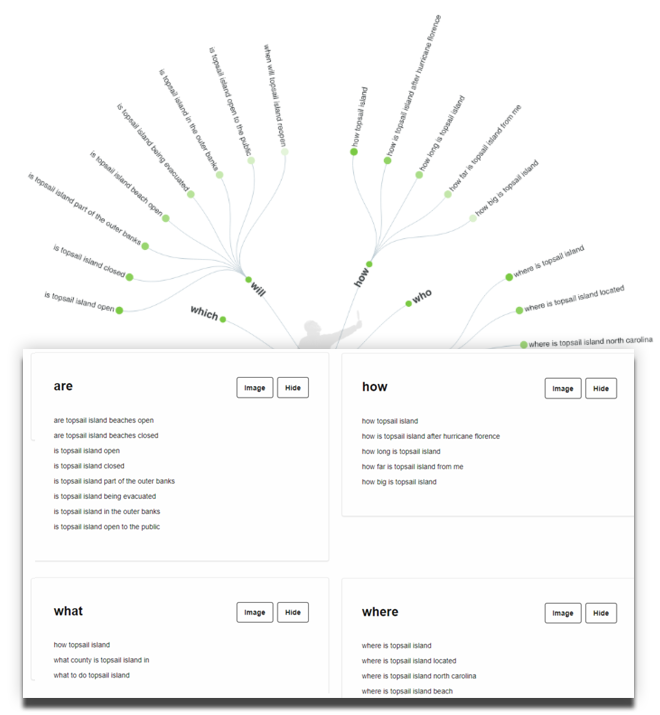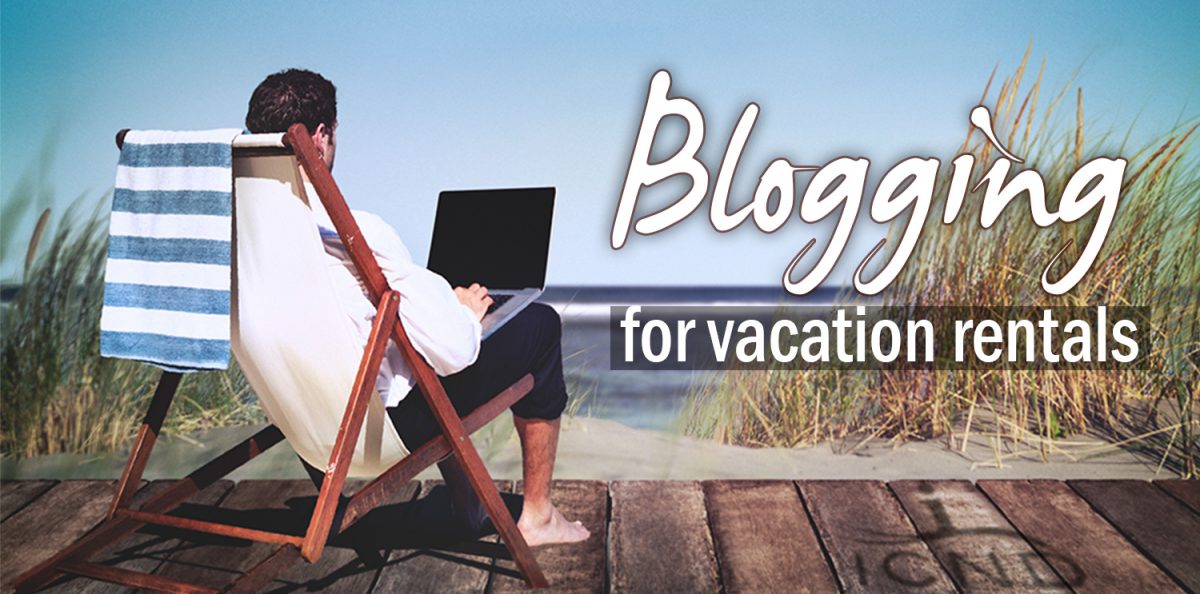One of the most common questions from companies in the vacation rental space I get asked time and time again is in regard to blogs. How should they be written? What’s standard practice? How many should I write? How long should they be? Do they help with SEO?
Let’s answer those, shall we!
Writing is half the battle, the other half is promotion
Ever heard of “if you build it, they will come?” Not the case with blogging! Just because you write the best blog post in the world, that doesn’t mean anybody is actually going to be able to find it. You need to spend half the time promoting it on your social channels or finding places out there on the internet (message boards, forums, etc, where you can post it.)
And don’t feel bad about promoting the same content over and over on social media. You can easily post the same blog to a social media channel twice a month and chances are, it will hit different audiences.
Always remember, just because you posted a blog, doesn’t mean you are done working on it!
Blogging about Attractions is Easy, but Not Always the Best
Rental companies often get caught up about writing about the things to do and attractions in the area. It’s easy content, right? But what is the end game of the content?
Are you trying to get that attraction (or top 5 list of attractions) to rank so you can gain traffic from it?
If you are, then why? Will ranking for an area attraction help get you more bookings and help you rank for “<my area> vacation rentals”?
Short Answer: No.
We’re not saying DON’T write about attractions, but definitely try to intermingle blog posts about “RENTALS” as well. If there is a major attraction in your area, then write a post dedicated to “Rentals near <attraction name>”, or write about “Best Condo Complexes with Oceanfront Balconies”, “Best Resorts to Watch the Sun Rise in <destination>” or write about your “Ski In Ski Out” accessibility.
Remember, you are trying to rank for rental style keywords. So make sure you have a lot of content surrounding rentals too.
Long Answer: Yes.
By having a website that has heaps and heaps of good quality content about your products (notice how quality is the keyword here), that does help boost your overall site authority with Google. But again, if your content is dull and has a low interaction rate, you might as well have not even written it at all.
Quality Over Quantity
“How many blog posts should I write per month?”
You have a choice. Write 4 blog posts that “skim the surface” of topics. Or write two blog posts that go into depth on those two topics. You should know by now that long-form content that is full of pictures, videos, graphics, links and thoroughly covers a topic will get ranked and get more traffic than a short one.
“Ok, then how many should I write then?!”
However many you can! If you only have time for one a month, then do one a month. If your staff has time for 4, then write 4. Everything helps. But just remember, make sure they are quality!
An EXCELLENT example is this post about pressure washing a house. It goes into every little itty bitty tiny weenie thing there is to know about pressure washing — even things you’ve probably never thought of or considered. It has charts and graphs, photos, illustrations and plenty of info about the subtopics too!
Finding the RIGHT Topics
I have one website name for you: AnswerThePublic.com. Head there and put in your destination. In this case, let’s use Topsail Island.

You will immediately see a slew of data there all revolving around topics that people search for regarding your destination. Pick one and write about it (but again, try to keep it rental related).
Pro Tip: You can even go a step further by typing in “Topsail Island rentals” or “Topsail Island vacations” to get rental and vacation rentals related info as well.
The downside of the tool is it doesn’t provide you with any sort of search volume. So we don’t really know HOW popular your topic is. Your marketing company SHOULD have a Moz, ahrefs, or SEMRush account though. With those, they will be able to find other questions and answers (as well as their volumes).
Perfect Vacation Blog Post Titles & Permalinks
When writing for SEO, you want to try to have your keyword(s) in both the blog Title and the blog Permalink. BUT, it also needs to be able to draw people in to want to click when they search in Google for it.
For example:
BAD: Let’s go for a walk on the beach!
GOOD: Top 4 Best Spots to Walk on the Beach in Topsail Island
The above BAD gives no context. What beach? Where? It also won’t rank for “walk on the beach topsail island” because it doesn’t have the destination in there. (Not only that, a user probably won’t click it). The GOOD is not only attractive and will entice clicks, but also has the destination in the title of the post. (Your vacation spot isn’t the only one in the United States that has a beach, you know.)
Always be thinking of ways to link to internal pages (and external too)
“Interlinking” is big with SEO. Always try to remember to link to other blog posts you have done, link to search pages and/or, link important pages on your website.
Example: The information in this blog post goes hand and hand with our content auditing guide for rental managers. By making links to these pages, you are passing “link weight” and “importance” to these pages other pages, thereby explaining to search engines they are important.
A great example of an internal link would be if you are writing about a certain home you have on your rental program that may be oceanfront. If you have a page dedicated to oceanfront rentals (which, you should), then find somewhere in that text to write “oceanfront rentals” or “oceanfront <location> home rental” or any variation of that theme. Link those words TO your oceanfront rentals page!
I guarantee you can go through all your old blog posts and find instances where you can link to other interior pages.
The same goes for linking externally too. (meaning, linking to other websites out there) Don’t be stingy! You want to benefit the reader and provide them with as much information as possible. So if there is an article, website, or reference out there you think you should link to, then do it. By doing this, you are becoming an authority.
Optimize Your Posts for SEO Value & The Reader
Very important to keep in mind that these days: you need to write for the human, not for Google. Stop worrying about keyword density and “using your keyword 3 times”, etc etc. The best blog posts are ones that are personable and easy to read. While the above does play a role, when you force it, the writing itself suffers.

Good writers can can marry up the two principles. There are some things you can do to make the blogs SEO friendly.
- If using WordPress (which is the norm), install the Yoast plugin & be sure to check all configuration settings. Have someone with SEO knowledge help you out with that if you are confused. (That could be an entirely different conversation.)
- When writing your posts, Yoast gives you suggestions on keyword density and “SEO Value”. Important to take note of these, but don’t strive to be perfect (as I stated above).
- Add Imagery – photos, charts / graphs, videos, infographics, etc. Think outside the box with this. “Words” aren’t the only content these days, so try to incorporate digital elements in there.
Warning! Before uploading images….
- Double-check copyright / know source, don’t just steal Google images, this could get you in trouble!
- Ensure the image is compressed for smaller file-size. Small file size = faster page load = better rankings
- Image filename – descriptive of the image itself, but do not force keywords in there
- After uploading and image: Include Alt attribute in image tags – use something similar to the blog’s overall topic
Break Up the Content with Section Headers – People Love to Skim!
Any good blog post these days is SKIMMABLE. Rarely does a user get to the end of a blog post and read the entire thing. There might be a specific section a reader is interested in, rather than the entire article. Or you might have different important topics to cover that need to be broken out into sections.
All of these “Section Headers” need to be in Header Tags. Which are broken down by h1, h2, h3, h4, h5, and h6. (It’s HTML terminology.) Too often, writers will use all H1 tags because they are “most important”, but you should use h2 or h3 for subheaders since the blog post title is usually h1. This is the natural hierarchy, and makes the most sense to users (and to Google.)
Confused? Try this example structure.
- H1 Tag (which is the blog post title)
- Content
- H2 tag
- Content
- H2 tag
- Content
- H2 tag
- Content
- H3 tag (if needed)
- Content
- H3 tag( if needed)
- Content
- H2 Tag
- Content
Try to Steer Away From Stock Photos (that look stock-y)
Not saying never use them, but you better believe there are users out that that see a beach photo and say “eh, that’s not Myrtle Beach”. Sure they are great when you have no other resources, but make an effort to showcase the area in which you live in with personal photos, not stock photos. Everyone has seen the same old stock photo, so get personal with your customers and show them what YOU see with your eyes. (Don’t forget, right clicking and saving from Google is a huge no-no, and can land you in a hotseat.)
Answer Frequently Asked Questions about Your Topic
So you get the same questions day in and day out. You have majority of those questions posted on your FAQ page. However you may get questions that do not fit in the FAQ page, or can be expanded on. Well, you have a blog and can write about it rather than clogging up your FAQ page. (A great interlinking opportunity!)
In The End
Wait, you got to the end of this? Congrats! Thanks for reading along! If you need help with any sort of vacation rental marketing (<— see what I did there? interlinking), whether it’s SEO, PPC, Social Media or Email, feel free to reach out to us at ICND. Hundreds of happy marketing clients!
 866.249.6095
866.249.6095